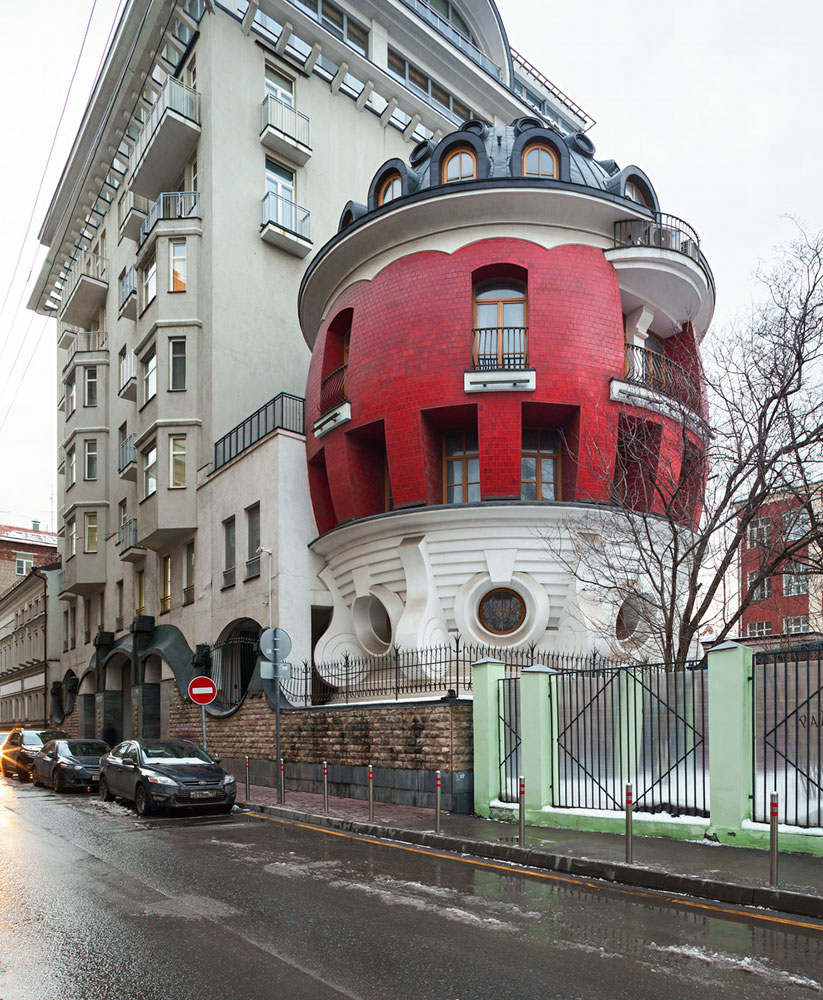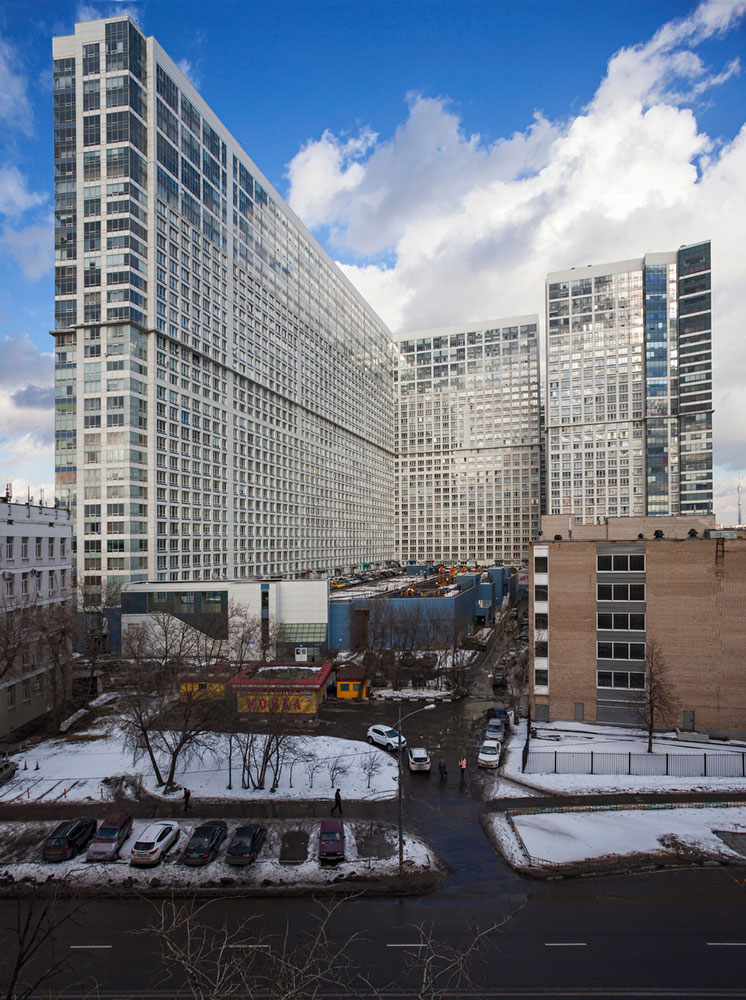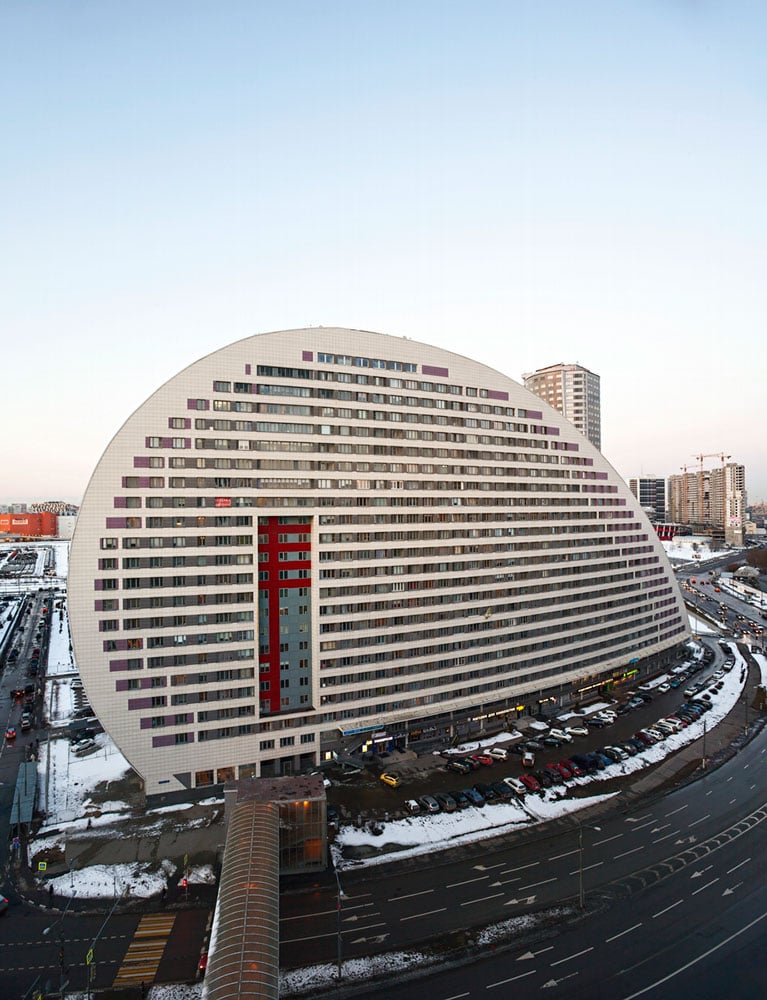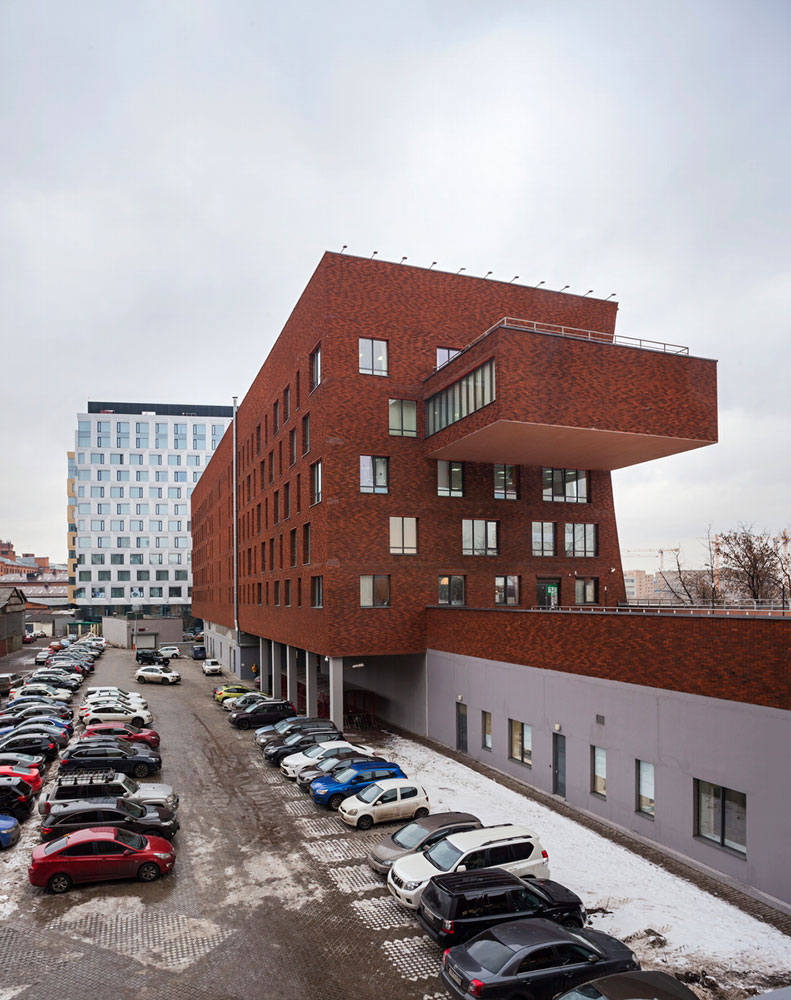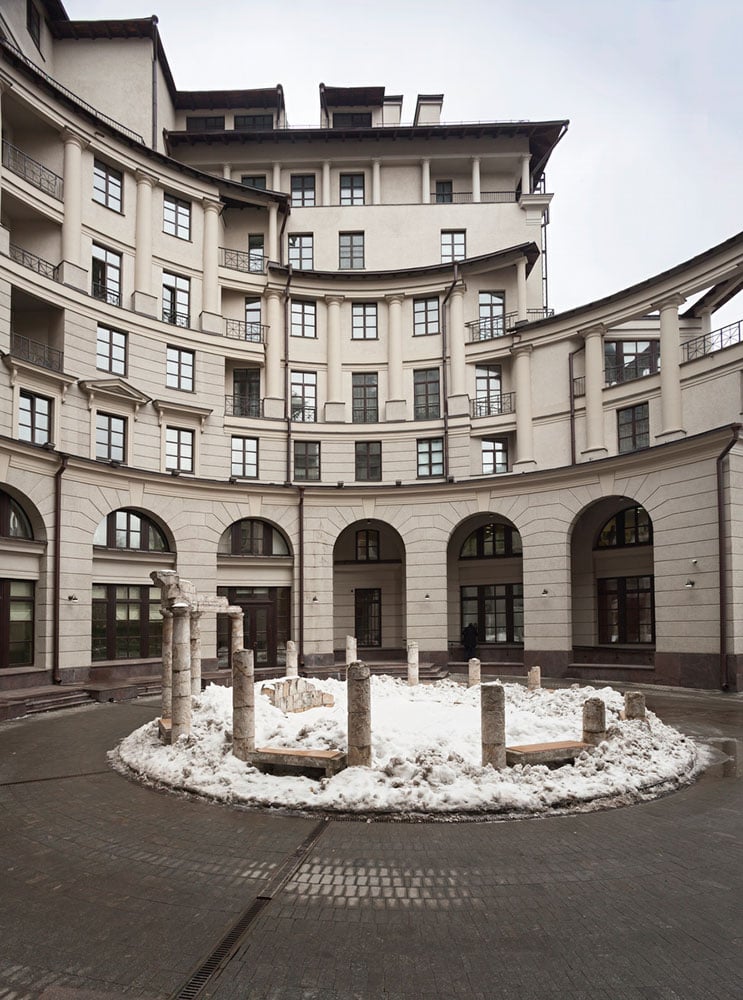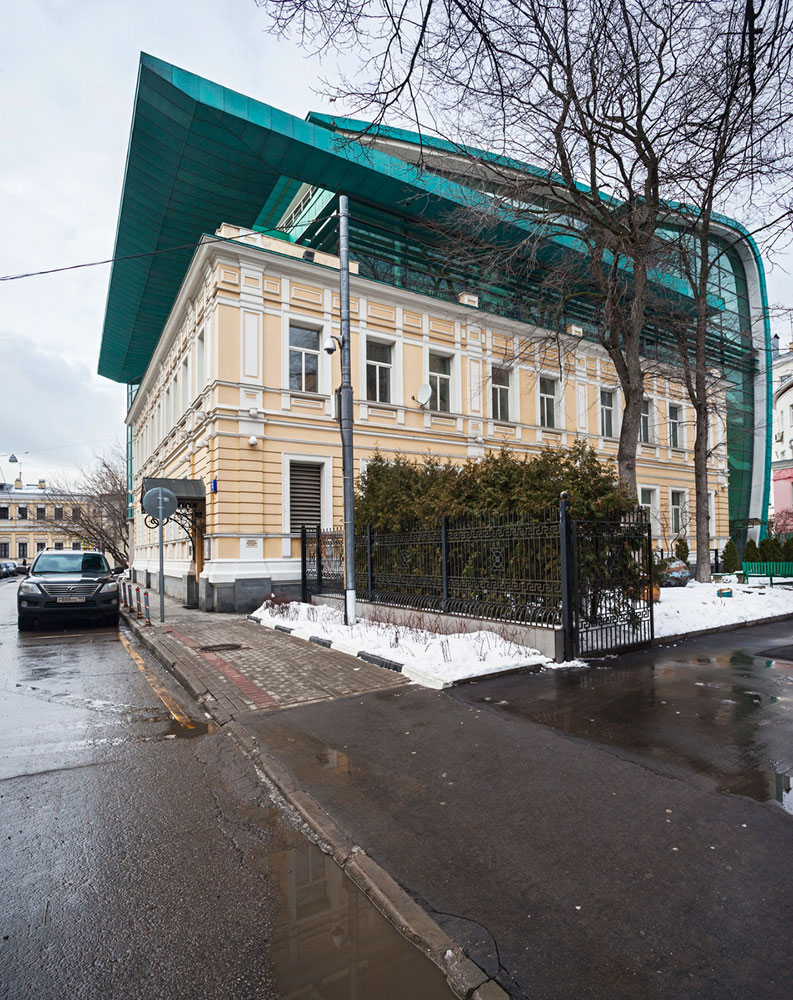Post-millenial Moscow: Vladimir Paperny on six types of 21st century architecture
Peter the Great, according to Karl Marx, used barbarous methods to eradicate Russian barbarism. The dismantling of Stalinist “architecture of socialist realism,” which started in 1954 under Khrushchev’s “thaw,” was done in a similar fashion. Young architects, often from provincial towns, rebelled against the Moscow architectural elite. One member of the young cohort, Georgy Gradov, expressed his hatred for both Stalinist Neoclassicism and 18th century Russian Classicism in this way: “When I look at St Petersburg’s Admiralty building [1706], I choke with class-based hatred.” In many cases, the fight resulted in stripping the members of the old guard of their titles, positions and, for some, sources of income. Another consequence of this battle was a partial rehabilitation of Constructivism — although not as a Utopian philosophy of creating a “better human being”, but as a cheap method of construction.
After the collapse of the Soviet Union, the the most profound changes happened in areas of artistic activity that required large-scale financing, mostly in architecture and film
Starting in the late 1950s, the new Soviet policy of better relations with the West and the gradual opening of physical and ideological borders, provided architectural students with access to the foreign press, from which they eventually learned the suppressed history of the Russian architectural avant-garde. The gap between the design ideas of Soviet architects and their counterparts in the West continued to be wide. In 1972, for example, as architects in the USSR were still struggling to rehabilitate modernism, Robert Venturi was already arguing “for inconsistency and against dry logic, for hybrids and against pure breed, for dirty life instead of clean schemes, for ambiguity rather than certainty,” thus becoming the unofficial “Father of Postmodernism” — a title he has always vehemently rejected.
In the 1980s, during Mikhail Gorbachev’s perestroika, architecture was not in the centre of public attention, as political reforms took centre stage. Architectural students and young architects, inspired by foreign architectural journalism, started imitating what they saw in magazines. “We worshipped magazines,” recalled architect Mikhail Fillipov. “We looked at a picture and imagined a reality behind it. A magazine was like a window to Europe (or rather to America and Japan).” Eventually, these architects found an outlet for their creative energy in the so-called Paper Architecture, architectural fantasies in Piranesian style, as well as in entries to competitions with conceptual or futuristic themes. Winning such competitions provided architectural students with opportunities to travel abroad and to meet international architectural stars. Some never returned to the motherland, just like the young Russians sent abroad by Peter the Great to learn arts and crafts.
The collapse of the Soviet Union in 1991, in the words of Russian economist Alexander Auzan, was “an unprecedented leap from the economy of scarcity to a consumer society”. The planned economy and government control over finances evaporated almost overnight. As a result, the most profound changes happened in areas of artistic activity that required large-scale financing, mostly in architecture and film. Literature, painting, theatre, music, and dance were already thriving in the 1980s during perestroika.
Architecture reflected the new economic reality in the most obvious and graphic way. Adopted in 1992, President Yeltsin’s decree on free trade converted virtually every square foot of major cities into a commercial resource. According to the decree, citizens and companies were allowed to trade “in any places convenient for them, with the exception of the carriageway streets, subway stations and the areas adjacent to the buildings of state bodies of power and administration”. For the next 18 years, the speed of changes in the country could only be compared with the two Russian revolutions of 1917.
The Stalinist revolution in architecture of the early 1930s had been perceived by some architects as “liberation” from the oppression of the strict “foreign-born” architectural theories. Similarly, Yury Luzhkov’s “Moscow style”, which was a homegrown version of western postmodernism, gave architects what they saw as “creative freedom.” A few different styles emerged. The architect and architectural historian Dasha Paramonova in her recent book Mushrooms and other mutants: the architecture of the Luzhkov era lists six types of buildings brought to life by the new economic reality: playful, modern, sculptural, contextual, neo and metabolic. I will borrow her classification to analyse some of the Moscow buildings of the Putin era.
Playful
The main attribute of this style is exaggerated irony. The best example is the Egg-House by Sergey Tkachenko’s Studio in 2002. The bizarre idea of creating a multi-story maternity hospital in the shape of a Fabergé egg in Bethlehem (!) was born in a conversation between Tkachenko and well-known gallerist Marat Guelman. Unable to find a sponsor in Bethlehem, they tried to build a reduced four-storey version at Patriarch’s Ponds in Moscow, which did not work either. Finally, the idea was transformed into a two-storey townhouse attached to an eight-storey apartment building. “We don’t like doing boring houses”, explained Tkachenko. “Although it is sometimes necessary. We like to make merry, and to tease others. To entertain ourselves.”
Modern
This style has references to both Russian Constructivism and its bastardised 1960-70s version. Occasionally, it also contains some not very obvious elements of playfulness. Vladimir Plotkin’s 2006 Aerobus residential complex in Moscow has 1984 apartments — a hidden reference to George Orwell? Considering that this tripartite complex is 120 metres high and 500 metres long, Orwell, indeed, comes to mind. Critics, however, argued that Plotkin’s clever use of volumes, angles, textures and patterns makes an enormous structure less intimidating and oppressive. The architect himself sees bigness in a positive light: “I think that if we live in a city of over 10 million people, it somehow must be expressed in architecture,” he says. “When we are dealing with such mega objects, everything changes. It becomes a fact of the landscape rather than an architectural form.” In 1995, Rem Koolhaas said something similar but much less positive: “Bigness is no longer part of any urban tissue. It exists; at most, it coexists. Its subtext is fuck context.”
Sculptural
This style’s origins may be traced to Erik Mendelson’s Einstein Tower or Le Corbusier’s Notre Dame du Haut in Ronchamp. But the post-Soviet sculptural style emerged at the time when Frank Gehry had already used CATIA software for his Bilbao Guggenheim. Architects Boris Uborevich-Borovsky and Andrei Bokov did not use any sophisticated software for their 2007 Sail-House apartment building in Moscow. At least one critic found the “hand-made” quality of the building endearing: “instead of the fashionable computerness we are dealing here with the eternal sculptureness.” The unusual shape of the apartment building, which has a rounded facade and curved plan, was born out of necessity: a curved street and the need for isolation for the school behind the building. From Muscovites, the building has acquired a few nicknames: the ear-house, drop-house, hill-house, wave-house, snail-house and whale-house.
Contextual
One way of understanding context was formulated by the Russian architect Alexander Skokan: “A building must enter the environment just as a person enters a room full of people. You can enter in dirty boots stomping loudly and start screaming. Or you can enter neatly dressed, politely introduce yourself and join the conversation.” Sergei Skuratov’s Danilovsky Fort residential complex to some extent fits Skokan’s definition. Built out of brick on the territory of a retrofitted textile factory in Moscow in 2008, the building blends well with the other factory buildings, which have been converted into offices. But Skuratov’s understanding of context is much more complex and includes literary references: “To such a site you should come with two friends. Start a bonfire, hang fish on a skewer, drink some vodka… The three buildings of this complex — they are just like the three men around a bonfire, they look like they’ve already eaten and drunk everything, and are in a good mood. All the windows are different, they dance; the buildings’ attire is appropriate — bricks. And the fact that they are five metres off the ground is perfectly understandable in such a state! And they remind you of Jonathan Swift’s Laputa.”
Neo
Neoclassicism. Canadian-American designer Karim Rashid called Moscow pseudo-postmodern architecture “cowardly.” Russian architects Mikhail Filippov and Mikhail Belov, founders of Paper Architecture, are now staunch classicists. Filippov’s Roman House and Belov’s Pompeii House, both built in Moscow in 2005, represent nostalgia for the European (Saint Petersburg) period of Russian architecture when the 18th century Italian architects were bringing open terraces to the cold shores of the Neva river. Here’s how Filippov describes his conversion from architectural fantasies to actual practice: “I painfully tried to invent the most original, the most marginal point of view. I wanted to be like nobody else. A proud, absurd and nonsensical idea that guides many artists. I must be honest with myself. I came up with this idea out of the desire to show off.” Of course, it takes courage to present something like the Roman House in the 21st century, but it is a social, not architectural kind of daring. Imitating the styles of the past is easier than finding your own way. In my view, Moscow pseudo-classical is bold posture but cowardly architecture.
Metabolic
Creative reconstruction, hybridisation of the past with the present. Not to be confused with Metabolism, a post-war Japanese architectural movement. Asadov Architectural bureau represents a more playful type of modernism compared to that of Vladimir Plotkin. Its reconstruction of the building of the Russian Architects’ Union (2006) is a daring juxtaposition of the old and the new making the preservationists furious. Critics compare this added volume to Bernard Tschumi’s concert hall in Rouen and Frank Gehry’s the Fisher Center for the Performing Arts at Bard College. Other critics point out that the old building is fake: it has been demolished and rebuilt from scratch, with an added underground garage, making it another Luzhkov-era muliazh (sham replica), like the Hotel Moskva and Voentorg department store. Aleksandr Asadov described his approach this way: “When two epochs collide, the old must remain old and the new — new. They should not imitate one another but coexist with dignity. The new architecture must at least be not boring.” Looks like fear of boredom is a recurring theme in post-Soviet architecture.
New vysotkas
The “architecture of socialist realism” is coming back, even though nobody still knows what exactly this expression means. The first signs of its return appeared in 2005 when the developer DONSTROI built something that could be described as vysotka (one of Stalin’s seven Moscow high-rises). It’s a luxury residential building 264 metres high called the Triumph Palace. Until recently, vysotkas were considered the most desirable type of residence despite their faults — small, poorly planned apartments, long narrow corridors and outdated water and sewage systems. This desire is probably a remnant of the Stalin era when only “very important people” could live there.
Two years later another tribute to the “architecture of socialist realism” was presented by a former Paper Architect, Mikhail Belov. To make the connection with the crumbled Soviet empire, this residential high-rise is called the Imperial House. “Too bad,” said one unnamed commentator in a blog, “his Paper Architecture was amazing, but his building…” The most symbolic aspect of the Imperial House is that it is built on the site of an unrealised Russian avant-garde project by Dutch architect Erick van Egeraat.
The ‘architecture of socialist realism’ is coming back
And finally, the dramatic story of the vysotka in Oruzheiny Lane. It was originally designed in 2006 by the long-time head of Mosproekt-2, Mikhail M. Posokhin. The construction stopped during the economic crisis of 2008. For about nine years, the abandoned skeleton stood in the busy intersection of the Garden Ring and Dolgorukovskaia Street, looking rather menacing. Sergey Sobyanin, the new Mayor of Moscow, announced a competition for finishing the building. One of the entries was from the Center Pompidou co-author Richard Rogers, but his proposal was rejected as inappropriate for Moscow. The winner was Mikhail Plekhanov from the same Mosproekt-2.
The finished building combines different styles and motifs. There are some traces of Kazimir Malevich’s arkhitektons; it brings to mind hotel New Yorker and the Rockefeller Center in New York; some critics see similarities with John Burgee and Philip Johnson’s PPG Place in Pittsburgh. Still, the most obvious reference point is a Stalinist vysotka. And, as if to prove this point, the building recently acquired a spire.
Text: Vladimir Paperny
Image: Egor Rogalev

